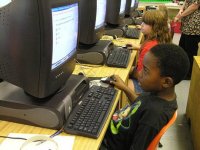The Pros and Cons of Computer Labs
I have spent six of my almost nine years of teaching in a computer lab. Over that time, my feelings about computer labs have fluctuated. It may seem silly for me to be in opposition to my own job, but there are times that teaching in a lab can be frustrating and isolating. On the other hand, there are times when I realized that there is no other place that my students would be learning how to program, edit videos, create music or format text documents.
Neither of the schools in which I have been the technology teacher have had a library, a librarian or access to much classroom technology in student hands. As such, I have found that my role as the "Computer Teacher" has actually been many roles. In that way, the computer lab was an important place in these schools. On the other hand, it is challenging to try connecting what is taught in the lab with what students are learning in their classrooms, which is, in my opinion, the ideal way to structure technology education.
Another challenging part of teaching in a computer lab is the room layout itself. Most labs contain desktops lined up against a wall in either rows or pods. These layouts, due to wiring and cables, are not mobile or adaptable. In my lab, my younger students can barely see over their computers to follow what is going on at the board. In other labs I have visited or seen, students must turn their bodies to view the board.
Making It Work
Most computer labs are also not laid out well for group work. Technology lends itself to project-based learning, and this can be hard to manage or coordinate in a classroom that is not conducive to moving furniture or creating space for groups or teams to work. Often, the computer takes up most of the desk or table space, too, so there is less room for teams to work out ideas before creating them on the computer. A lot of this work must be done in the classroom before they get to the lab, which means that, even when groups are ready to start creating on the computer, they must wait until the day they use the computer lab. This interrupts the creative and design process and inserts an artificial break between the work students are doing and the technology they are using.
However, despite this, I know that there are certain computer literacy skills students are taught in a computer lab that make integrating technology in the classroom easier. If a teacher knows that students have a period or two each week for learning how to edit video, format text, manage files or create websites, then that is less instructional time in the classroom they have to spend teaching these skills. It allows them to focus on the content and process rather than specific computer skills.
Basic pros and cons of computer labs:
Pros
- Each student has a machine. Unlike classroom pods or clusters in the library, most computer labs have enough machines for each student.
- Focused computer literacy instruction. Computer labs that have a teacher and are not just a room of computers provide students access to specialized computer literacy education.
- Provide access in schools with no libraries or funding for large tech initiatives. The bottom line is, if a school does not have a library or can't afford to put a lot of technology into its classrooms, then a computer lab is a viable solution to provide access to students for digital learning.
Cons
- Limited access as a shared resource. Since labs are separate from the classroom, they are not immediately available and are often shared among many classes.
- Technology removed from classroom. When students have to travel to the computer lab, it means that technology is not truly integrated into the curriculum. Having technology in a separate room sends the message that technology is separate from what students are learning in the classroom.
- Room layout. This could be one of the most frustrating things about teaching in a computer lab. The layouts of most computer labs are rigid and fixed and do not lend themselves easily to dynamic lessons or projects. In addition, there is rarely room for real work, since keyboards and mice usually take up most of the desktop space.
If you have discovered any additional pros or cons in the computer lab at your school, please share them in the comments section below.
